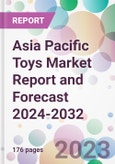The Asia Pacific, home to a diverse tapestry of cultures, traditions, and economic standings, has always been a robust playground for the toy industry. The variety of toys is staggering - ranging from traditional handcrafted dolls in Japan to modern electronic toys in urban centres like Shanghai and Seoul.
A major driver for the Asia Pacific toys market growth is the growing middle class, particularly in countries like India, China, and Indonesia. As households see a surge in disposable incomes, parents and guardians are more willing to spend on high-quality toys that promise both entertainment and educational value.
In the vein of education, STEM toys have witnessed a significant uptick in demand across the region. With Asian economies progressively steering towards technology and innovation-centric growth, parents are recognising the value of toys that foster analytical thinking and creativity, driving the STEM toy segment, and further propelling the Asia Pacific toys market demand.
Another critical driver in the market is the region's role as a manufacturing hub. Countries like China are not only significant consumers but also dominant producers, catering to both domestic and global demand. This dual role ensures a constant evolution in design, innovation, and price points, making the market both vibrant and competitive.
The integration of technology into toys is one of the crucial Asia Pacific toys market trends. Augmented reality, miniature robotics, and app-integrated toys have found a receptive audience in tech-savvy regions like South Korea and Japan. However, this technological trend isn't just limited to the affluent markets. Even in emerging economies, digital integration in toys, driven by the proliferation of smartphones and affordable internet, is gaining momentum.
The eco-conscious movement, while having its epicentre in the West, has made significant inroads in the Asia Pacific region. There's a budding demand for toys made from sustainable materials, with both consumers and manufacturers showcasing an increased responsibility towards the environment and further increasing the value of the Asia Pacific toys market size.
Market Segmentation
The market can be divided based on product, age group, distribution channel, and country.Market Breakup by Product
- Action Figures
- Building Sets
- Games and Puzzles
- Dolls
- Sports and Outdoor Toys
- Plush
- Others
Market Breakup by Age Group
- Up to 5 Years
- Between 5 to 10 Years
- Above 10 Years
Market Breakup by Distribution Channel
- Hypermarkets and Supermarkets
- Departmental Stores
- Online Channels
- Others
Market Breakup by Country
- China
- Japan
- India
- ASEAN
- South Korea
- Australia
- Others
Competitive Landscape
The report looks into the market shares, plant turnarounds, capacities, investments, and mergers and acquisitions, among other major developments, of the leading companies operating in the Asia Pacific toys market. Some of the major players explored in the report are as follows:- LEGO System A/S
- Bandai Namco Holdings Inc.
- Hasbro, Inc.
- TOMY Company, Ltd.
- Mattel, Inc.
- Guangdong Gaole Co., Ltd.
- Rastar Group
- Dream International Limited
- Playmates Toys Limited
- S M Funcorp Toys Private Limited
- Others
Table of Contents
Companies Mentioned
- LEGO System A/S
- Bandai Namco Holdings Inc.
- Hasbro Inc.
- TOMY Company Ltd.
- Mattel Inc.
- Guangdong Gaole Co. Ltd
- Rastar Group
- Dream International Limited
- Playmates Toys Limited
- S M Funcorp Toys Private Limited
Methodology

LOADING...








